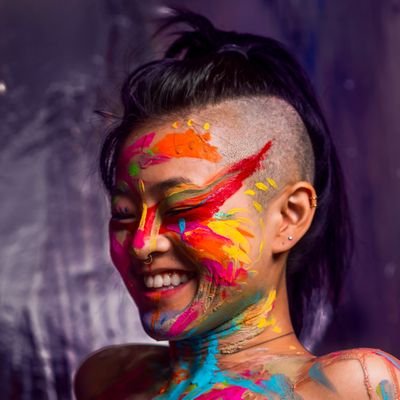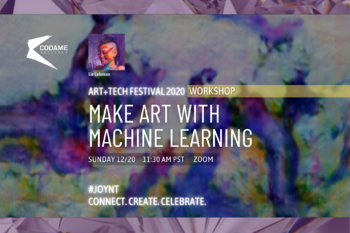Lia Coleman is an artist, AI researcher, and educator based in Puebla, Mexico. Her interests lie in AI for artwork, online education, and public murals. These days, she helps others learn how to create artwork with AI, and teaches online workshops on creating AI art with Derrick Schultz.
Lia has taught at RISD as a visiting AI artist and researcher in ML art. Recently, she collaborated with the Partnership on AI to create a field guide for artists to use ML in an ethical manner. In 2019, Lia's AI research and artwork were accepted to the NeurIPS Machine Learning for Creativity And Design Workshop, where she presented a poster of her research. Lia's writing on AI artwork and new media art have been published in Neocha Magazine, and her work has been exhibited in Vancouver, Seattle, NYC, and Boston.
Lia is an alumni of the School for Poetic Computation in NYC, and holds a Bsc in Computer Science from the Massachusetts Institute of Technology.
Interview with Lia Coleman
Tell us about your background
I'm trained in machine learning and computer science. At the same time, I've been a lifelong artist and been creating as far back as I can remember. For a year and a half, I worked as a machine learning engineer before realizing that I needed to have more creativity in my day-to-day. It sounds cheesy, but I realized that I can't exist without art as a daily part of my life. Creating is as essential as water and air to me. For me, living a life without art is suffocating.
What is your definition of art + tech?
Art and tech are just two different ways of framing and perceiving the world around us. The union of art+tech is what is created when these two modes of thinking merge in a symbiotic way. Art carries creativity, expression, a voice, a message. And tech brings tools to play with, techniques and mediums to explore, and beauty and elegance. There is a lot of room for them to bolster the other up, in a symbiotic, potentiating way. And when you look through both of these lenses, something powerful and beautiful is created.
Who, or what, inspires you in your art and in your life?
I'm inspired by Derrick Schultz, my co-teacher in our AI art classes. I'm amazed by him-- his auto-didacticism, his technical knowledge, and his natural ability to teach and empathize with others. In our classes, we try to foster a environment of care where you feel completely at ease, where these high and lofty ideas like "machine learning" are made approachable. Derrick and I work really well together because we agree wholeheartedly in creating an environment of care in our classes.
For art that moves me-- Daito Manabe's drone work with Elevenplay was the first time I saw something so beautiful, and at the same time, extremely technically challenging. There's something indescribably poetic about it. My favorite piece is his collaboration with Nosaj Thing, which, without fail, always makes me tear up.
In my personal life, Daito's work was crucial in giving me the push to leave my job and take the plunge into creating art full-time. It opened my eyes to what was possible. So I'm forever thankful for that, and to him.
As for AI influences, I really love the work of Kishi Yuma, Esteban Salgado, and Naoko Hara. Kishi Yuma is a Japanese AI artist, whose work inspires my own work, and who I had the pleasure of interviewing earlier this year. Esteban and Naoko are two of my former students, who are now my colleagues, who both do really amazing work. I love how they bring their own existing styles as a collage artist and motion designer, respectively, into their AI artwork. It's beautiful.
What is your process or techniques for creating your work?
I've been using generative ML models, with a focus on StyleGAN. My artistic process starts off with collecting a dataset of a few thousand images. Next, I train the model on Google Colab or another cloud GPU service. Then, once I have a trained model, I spend the majority of my artistic process doing manipulations on that trained model— generating new images, doing latent space walks, fleshdigressions (a technique from @AydaoGMan, etc.
I almost always try to sync up my generated videos to audio as well, because music adds a completely different shape and dimension to the work. Music helps fill my work out and making it feel more whole.
Aside from the post-training manipulations that I mentioned, the creation and cleaning of the dataset is the other most-lengthy part of my artistic process. It's laborious and repetitive, but well worth the work!
Are there any technologies that you are excited about working with or that have been a game changer for you?
Recently I've been moving towards using my own work in my datasets instead of scraping images from the internet. I'm currently working with a dataset of I filmed of my own face and body. I'm also now collaborating with a few musicians in the spirit of keeping everything in-house.
Next, I'm interested in trying out StyleTransfer on video, a la the work of Lulu xXX
What’s next for you as an artist?
I've been doing a lot of teaching lately, and haven't had a lot of free time for my own production, exploration, and expression. Don't get me wrong, I absolutely love teaching, and I always get inspired by the creative directions that my students take— but I do want to devote more time to my own production of art.
What does this look like?
First, I want to produce a lot more AI artwork. Playing with new datasets that I film myself, collaborating with musicians, finding new and fun ways to interact with ML models, like with audio or with controllers.
Second, I like art that lives somewhere— on a wall, on a body. (Aside from making AI art, I've been painting murals and designing tattoos.) So maybe in terms of my AI art this looks like projection mapping on the side of a building, or VJ-ing with an ML model during a live concert. I'd also love to play with different real-time interaction methods, like Kinect or audio/voice input to control and manipulate a model, so people can play and interact with these models and see their effects immediately.
What is your dream project?
On the longer-term scale, once we can go out in public again, I want to create site-specific public art happenings— aka quick-deployed shelters and inflatables for everybody to play with, touch, and climb on. Two or three months before the pandemic hit, I installed a reactive inflatable shelter for a showcase at School for Poetic Computation. Back then, I had the intention of spending a good portion of 2020 elaborating more on the themes of care, quick-shelter, and connection. Specifically, I was planning to design and fabricate quick-deploy inflatable shelters for guerilla art installations or Burning Man, but my direction changed when the world changed. However, I'm determined to make inflatable shelters happen one way or another, once the world atmosphere is allowing!
Anything you've thought of exploring if you had the freedom of an anonymous alias?
There's not really anything I would feel more comfortable doing hidden and anonymous. I feel like I'm pretty above board and upfront. I believe in the good of the art that I want to create. So there would be no reason to need to hide behind a moniker. If I had to pick something though, it'd probably be VJing (to get over stage fright) or putting guerilla art on the sides of buildings like projection mapping or overnight pop-up wheat-pasted murals.
What’s the greater purpose behind your artwork?
That's a tough question. It's hard to see the forest from amidst the trees. But as you create more work, you see what themes you always return to as an artist.
Over the years, I've seen myself making work that is calming, playful, and aims to foster feelings of child-like wonder, entrancement, and connection through touch. Generally, I want people to be have experiences of sheer joy, fun, and surprise, and I want that to be available and accessible for anyone to enjoy. So making public art or giving away my art is really important, and so is sharing my art through teaching.
My artist statement says it best:
I think about what happens when two things meet. “With whom is my art co-habitating?” I ask, whether I am working on a mural for a living space, or conceiving a tattoo that will sit on a friend’s shoulder. I consider art in conversation with the space in which it lives—its home—and the people with whom it lives—its friends and family.
I aim to give my work an unmistakable backbone and a gentle hand. My work is characterized by clear-cut solid lines, but also pirouettes, and colors that tickle. It reaches out and invites you to play, tap, handle, press, and unfold.
I often give away my art and consider teaching a part of my practice. I value increased access, community ownership, and public art. Educators, community leaders, and parents are my role models.
What’s the best piece of advice you’ve been given?
"People walk around like, 'Someone has my dream life...'
Bitch, if it's your dream life, no one can do it better than YOU can. Your reality is all up to you. Your misery, your dreams... You have the option to change your reality at any moment that you want. If you really want something, you'll seek it through. You can do anything you want in this world, you really can... I don't doubt anything anymore."
This is a quote from the 1-year reflections of Kalee Choiniere, a muralist and painter in Seattle, on the 1-year anniversary of her decision to stop solo-hiking after 6 months in the woods and devote her time to painting when she came back. I encourage everyone to listen to them. (It's up on her IG highlights.)
I agree 100% with her— For me, it's beautiful that I have free will, and the agency to forge my own future. Something that's easy to forget in our daily lives is that we're here walking on this path of life, and you can choose to turn and recalibrate whenever you want, because it's all for you. And you don't need to feel guilty about that. There's no one else that this life is for. The decision to quit your job, to move to a different country (hell, I'm living in Mexico right now!), to change your career, to change your life— it's yours.
Of course, you might have dependents, kids, family, a pet, or other obligations that make certain decisions more complicated, of course, but things can be worked out and compromises can always be found. There's always a way. We have a lot more agency than we give ourselves credit for.



